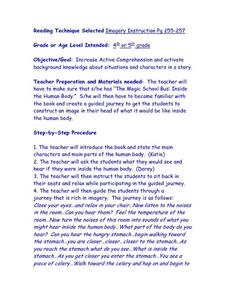Alabama Learning Exchange
Amazing Adaptations - Probing Pinnipeds
Fourth graders collect data about the habitats of pinniped adaptations using digital probes. They determine how pinnipeds make adaptations to their natural environment by completing an experiment to determine how human and pinniped...
Curated OER
Using Standard Deviation, part 2
Students explain and learn the practical application of standard deviation. They compare cities in the U.S. and discover whether cities closer to the ocean have more consistent temperatures. Useful resources are given.
Curated OER
Making Mummies
Students examine how mummies are made. In this ancient mummification lesson plan, students discover types of mummies and discuss the environments naturallly preserve bodies. Students research noteable mummy discoveries and present their...
Curated OER
Imagery Instruction
Students study how imagery affects their comprehension of stories. They participate in a guided journey of The Magic School Bus: Inside the Human Body. They compare the information from the book and their guided journey.
Curated OER
PLANETS IN PROPORTION
Students discover scales for both the solar bodies' relative sizes and their distances from the sun. They find equatorial circumference and volumes of their solar bodies. Students apply estimation strategies and proportioanl reasoning to...
Curated OER
"Weather" or Not?
Students complete a three week unit about weather and how it affects our behavior. They read and discuss various books related to weather, conduct an experiment about the tilt of the earth, plan a field trip based on temperature,...
Curated OER
Rate Law Problems
In this rate law instructional activity, students calculate the rate of reactions at specific temperatures with the given rate law for the reaction. This instructional activity has 5 problems to solve.
Curated OER
Testing the Waters
Eleventh graders examine a local body of water. In this science lesson, 11th graders collect water samples to test. Students analyze the data and make conclusions. Students create tables and graphs of the data.
Michigan Sea Grant
Water Quality
Learners observe water samples and measure the samples' water quality. Students develop their own criteria for measuring water quality and test for temperature, acidity, oxygen levels, turbidity, conductance, sediment and hardness.
Curated OER
Factors That Affect Climate
Fifth graders use captured portions of the Internet ("mininets") to perform research into climate. They create graphs of the data recorded using latitude as the independent variable and temperature as the dependent variable.
Curated OER
Yeast Fermentation
Students measure the temperature change involved in the production of carbon dioxide by yeast. They also identify products and reactants in a chemical and balance the equation.
Curated OER
Sun Seeking Plants
Pupils investigate the story "The Tiny Seed" by Eric Carle. This story is used to introduce the children to the concept that seeds change and grow into plants when conditions in the environment including temperature, light, water and...
Curated OER
International System of Units: Metric System
Students listen to lecture on metric system, make vocabulary book containing at least fifteen related terms, measure length, mass, and volume using appropriate metric units, and measure temperature using Celsius scale.
Curated OER
Solutions Homework Problem Set
In this chemistry worksheet, students determine the vapor pressure of a solution when dissolved in water at a set temperature. Then they determine the vapor pressure of this solution at a higher temperature. Students also explain the...
Curated OER
North America Puzzle Answer Sheet
In this geography worksheet, students name the capitals of various countries found in North America. They also identify the various weather patterns across the continent and specific bodies of water. There are 21 descriptions and 21...
Curated OER
Direct and Inverse Variation
In this direct and inverse variation worksheet, 9th graders solve 10 different problems that include various situations in variations. First, they find the constant of proportionality when given each variable measure. Then, students...
Curated OER
What Is In The Water?
Students investigate the biotic and abiotic factors that are found in an aquatic ecosystem. The emphasis is upon the investigation of present an projections of future water quality. Then students visit a local body of water to gather...
Curated OER
What a Can Can Do
Students explore the properties of a can. In this aluminum science lesson, students conduct various experiments to identify properties of aluminum. Students examine the appearance, temperature, and corrosion resistance of aluminum.
Curated OER
Geographic Context for War
Students explore the geography of Korea. In this Korean War lesson, students examine maps of the country and label landforms, bodies of water, climate, population centers, and neighboring countries to determine the significance of...
Curated OER
Weather Olympics
Students consider the effects of topography on climate patterns. In this earth science instructional activity, students research weather patterns and make inferences of how the land forms may create different climates. Students compare...
Curated OER
Stomach Chemistry
Fifth graders compare physical and chemical changes. They perform a simulation experiment/activity that replicates what happens in the stomach as food is digested by stomach acids.
Curated OER
Physical vs. Chemical Changes
In this chemical reactions instructional activity, students read about the differences between physical and chemical changes in substances. Then students identify situations as either an example of physical or chemical change. Students...
Curated OER
Cardiac Output, Rates of Change, and Accumulation
Students explore rates of change. In this cardiac output lesson plan, students measure the amount of blood being pumped by a heart. They explore the flow rate and complete an accumulation and concentration problem. They analyze data,...
Curated OER
Weather and Oceans: Uneven Heating of the Earth
Students investigate what causes the heat on Earth. In this Earth heating instructional activity, students experiment with different heat sources and determine where the Earth gathers the most heat. Students explore vocabulary words...
Other popular searches
- Body Temperature Regulation
- Body Temperature Control
- Body Temperature in Animals
- Normal Body Temperature
- Control of Body Temperature
- Altered Body Temperature
- Controlling Body Temperature
- Measuring Body Temperature
- Body Temperature Taking
- Maintaining Body Temperature
- Body Temperature Regualation
- Altered Body Temperature Ppt

























